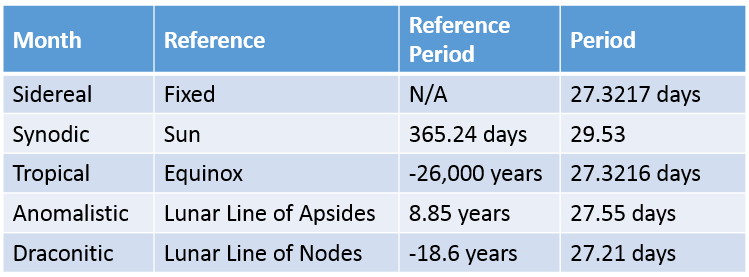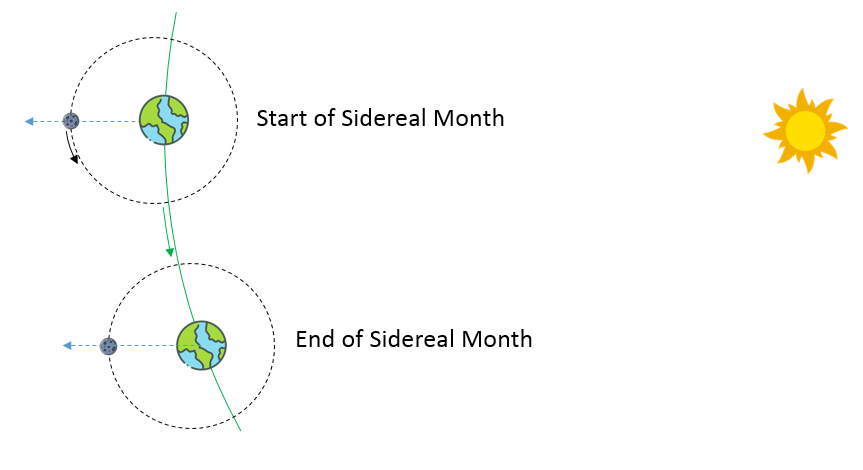Lunar Months
By Spencer Connor
With our current Gregorian calendar it is easy to forget that months were originally intended to correspond to lunar cycles. Imagine a scenario where the first of each month was always a full moon and the 15th was always a new moon, would it change anything about our lives? Probably nothing substantial, but it’s an interesting scenario to envision. While the moon was useful in antiquity as a medium length clock synchronized across geography, the reality is that it does not have the seasonal or agricultural significance of the year and can be fairly painlessly superseded by counting days. As a result the lunar month has been abandoned in favor of more convenient “artificial” months that we use today.
However, for astronomical events such as eclipses it retains its importance. One thing that is quickly confusing for those interested in the subject is the different types of lunar months. Fundamentally, the only difference between their definitions is the reference to which the moon must return to complete one orbit (one lunar month) and their duration only varies based on how that reference is moving and in what direction.
Sidereal Month (27.3217 days)
From a point of view of looking down on the solar system, the sidereal month would be the most intuitive definition of what a lunar orbit period (a lunar month) should be.. Sidereal as a term is used in astronomy to reference an inertial frame of reference, usually described as “relative to the stars”. As such, a sidereal lunar month is the time it takes for the moon to complete one orbit relative to a fixed reference and disregarding any other effects.
Synodic Month (29.5306 days)
From the standpoint of an earth viewer, a synodic month is the most intuitive definition. When we look at the moon the easiest thing to recognize is the phase, rather than precisely where among the stars it is positioned. As such, the synodic month is the time between full moons, or the time between new moons (together called syzygies). The difference from a sidereal month is that the moon phase is a function of primarily the lunar orbit, but also the earth’s orbit around the sun. There is in fact one less synodic month in the year than sidereal month as the earth completes a full revolution around the sun, leaving the synodic month longer than a sidereal month.
Tropical Month (27.3216 days)
A tropical month is very minor variation of a sidereal month that uses the March equinox as the reference frame rather than the fixed stars. Because the equinoxes slowly precess retrograde, the moon arrives at this reference slightly faster than a truly inertial frame. Therefore a tropical month is slightly shorter than a sidereal month, and with the period of precession of the equinoxes around 26,000 years this is a truly minor deviation from sidereal months.
Anomalistic Month (27.5545 days)
An anomalistic month is similarly most easily understood as a variation of the sidereal month but with a slowly moving reference frame giving it a slightly altered period. In this case the reference is the line of apsides (the line from the highest point in orbit, apogee, to the lowest point in orbit, perigee) as the angular reference. The line of apsides of the moon’s orbit precesses forward with a period of about 8.85 years, so it takes longer for the moon to reach the same point in apsidal frame (say apogee) and results in a slightly longer month than sidereal.
Draconitic Month (27.2122 days)
An draconitic month (also called a lunar month) is most similar to an anomalistic month, except that rather than using the line of apsides as the reference it uses the line of nodes. This line of nodes is the intersection of the plane of the moon’s orbit around the earth and the plane of the earth’s orbit around the sun (the ecliptic). On one end of the line of nodes is the ascending node (where the moon passes through the ecliptic going upwards) and on the other end is the descending node (where the moon passes through the ecliptic doing downwards). The line of nodes precesses with a period of 18.6 years opposite the direction of the moon’s orbit, therefore a draconitic month is faster than a sidereal month.






